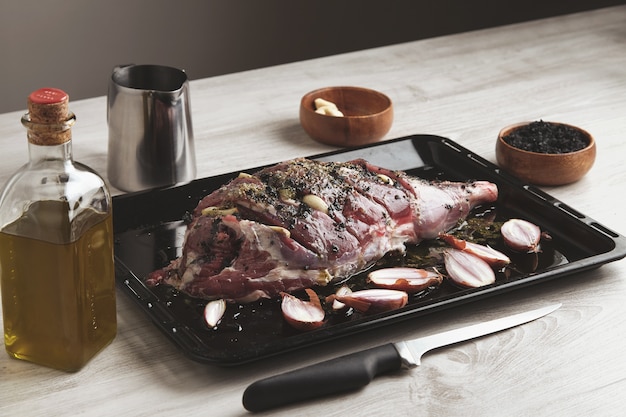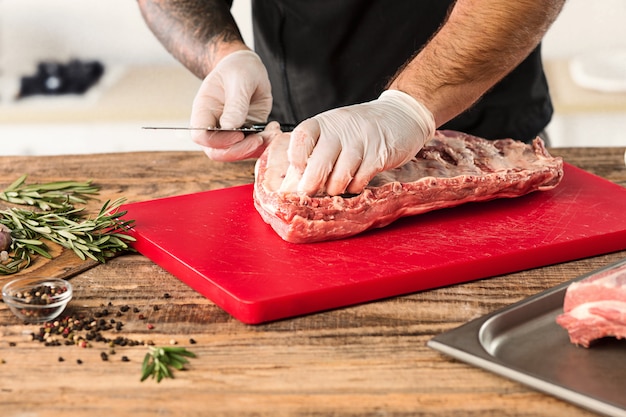The Cut Makes All the Difference: Bone-In or Boneless?

Before you even start thinking about cooking, you need to choose the right cut of rib eye. This is the foundation of your deliciousness, and it all comes down to marbling, that beautiful swirl of fat throughout the meat. Marbling is what gives rib eye its incredible flavour and tenderness. Now, I'm a bit of a purist when it comes to rib eye. I love the rustic charm of a bone-in cut, the extra flavour it adds, and the satisfying visual appeal. Plus, it just feels more authentic, a bit more "steakhouse" if you know what I mean. However, if you're looking for a more manageable cut, a boneless rib eye is perfectly fine.
Marbling Matters: Choosing the Right Grade

The level of marbling is what truly separates a good rib eye from a truly great one. You want a cut with good marbling, which is usually graded as "Choice" or "Prime" in the US. This means the steak has a good amount of marbling, which will translate to juiciness and flavour. You'll often see a "Prime" grade on the sticker, and while it's more expensive, it's totally worth it in my opinion. The higher the marbling, the more expensive the steak. Don't be afraid to ask your butcher for recommendations. They'll be able to point you in the right direction based on your preferences and budget.(Part 2) Preparing Your Steak: Setting the Stage for Flavor
Pat It Dry, Don't Wash It!: The Crucial First Step

Once you've got your perfect rib eye, it's time to get down to business. And let me tell you, there's a right way and a wrong way to prep your steak. First, pat it dry with paper towels. Don't even think about washing it! Washing your steak with water just dilutes its flavour and makes it harder to get a nice sear. We want that beautiful, crispy crust, and washing it will only hinder that.
Seasoning: Simplicity is Key
Next, we're going to season your steak, but remember, less is more. Salt and pepper are all you really need. They're the classic pairing for a reason, bringing out the natural flavours of the beef. But if you want to get a bit fancy, you can add a touch of other spices like garlic powder, onion powder, or smoked paprika. Just be careful not to overdo it, you don't want to mask the natural flavour of the beef. (Part 3) The Art of the Sear: Achieving that Perfect Crust
High Heat is Your Friend: Building Flavor and Texture
Now, here's where things get exciting. It's time to sear your steak, and this is truly a critical step in achieving that perfect rib eye. You want a nice, crispy crust on the outside while keeping the inside juicy and tender. The key here is high heat. I prefer to use a cast-iron skillet, but you can also use a grill or a pan on the stovetop.
The Sear: Patience is a Virtue
Make sure your pan is piping hot before you add the steak. It should be screaming hot, almost smoking. Then, place the steak in the pan and let it sear for about 3-4 minutes per side, without moving it. The temptation to poke and prod will be strong, but resist! You want to give the steak time to develop a nice crust. Let it sit undisturbed, building flavour and texture.(Part 4) Bringing It to the Right Temperature: Master the Internal Heat
Rest It, Rest It, Rest It!: The Key to Tenderness
Once you've seared your steak, it's time to bring it to the desired temperature. Now, this is where things get a bit more technical. You can use a meat thermometer to get the perfect temperature. I generally aim for medium-rare, which is about 130-135 degrees Fahrenheit. It's juicy, tender, and has a beautiful pink center. But it really depends on your preferences. Some people prefer medium, medium-well, or even well done. Whatever your preference, a thermometer is your best friend.
Finishing Touches: Taking It to the Next Level
Now, here's where you can really make your rib eye shine. I like to finish my steak in the oven at a lower temperature, about 300 degrees Fahrenheit. This allows the steak to cook evenly and helps to lock in all the juices. It's a subtle but important step in achieving that perfect texture. But, if you're feeling adventurous, you can also finish your steak on the grill or in a smoker. It's all about experimenting and finding what works best for you. (Part 5) The Final Touches: Elevating the Experience
Let It Rest: Allowing the Juices to Redistribute
Once your steak is cooked to your liking, let it rest for at least 5-10 minutes before slicing and serving. This gives the juices a chance to redistribute throughout the steak, resulting in a more tender and flavorful bite. It's the final step in ensuring that every bite is as delicious as the first.
A Touch of Butter: Adding Richness and Flavor
Now, this is my little secret. While the steak is resting, I like to add a knob of butter to the pan and let it melt. Then, I spoon the melted butter over the steak. It creates a beautiful glossy finish and adds a layer of richness and flavour that's simply irresistible. Trust me, it's a game-changer.(Part 6) Serving Perfection: The Art of Presentation
Don't Overcrowd the Plate: Let the Steak Shine
When it comes to serving, simplicity is key. You want your rib eye to be the star of the show, so don't overwhelm it with too many sides. I like to keep things classic. I usually serve my rib eye steak with a side of roasted vegetables, mashed potatoes, or a simple green salad. And don't forget the sauce! A red wine sauce, a creamy mushroom sauce, or a chimichurri sauce are all great options. They complement the flavour of the steak without overshadowing it.
Presentation Matters: The Visual Appeal
Don't forget about presentation. A nicely plated steak makes a big difference. Slice your steak against the grain, meaning slice it perpendicular to the muscle fibers. This will make the steak easier to chew and more tender. And don't be afraid to get creative with your plating. A beautiful arrangement will enhance the dining experience. (Part 7) Wine Pairing: The Perfect Complement
A Match Made in Heaven: Elevating the Flavor Profile
No good steak is complete without a perfect wine pairing. And when it comes to rib eye, there are a few great options. I tend to go for a Cabernet Sauvignon or a Merlot, but a Malbec or a Zinfandel would also work well. These wines have bold, complex flavours that complement the rich flavour of the steak.
Think About the Sauce: Balancing Flavors
If you're serving your steak with a sauce, make sure to consider that when choosing your wine. For example, a creamy sauce will pair well with a richer red wine, while a lighter sauce will pair well with a more delicate red wine. The goal is to create a harmonious balance of flavours. (Part 8) FAQs: Your Burning Questions Answered
What's the best way to cook a rib eye steak?
The best way to cook a rib eye steak depends on your preferences. If you like a crispy crust and a juicy interior, then searing it in a hot pan or on a grill is the way to go. This method allows the steak to develop a beautiful crust while keeping the inside tender. If you prefer a more evenly cooked steak, then baking it in the oven is a good option. The oven provides consistent heat, ensuring that the entire steak cooks evenly.
How long should I cook a rib eye steak?
The cooking time for a rib eye steak will vary depending on the thickness of the steak and the desired level of doneness. A general guideline is to cook a 1-inch thick rib eye steak for about 4-5 minutes per side for medium-rare. Remember to use a meat thermometer to ensure you achieve your desired level of doneness.
What temperature should I cook a rib eye steak to?
The ideal temperature for a rib eye steak depends on your personal preference. Here are some common temperature ranges:
| Doneness | internal temperature (°F) |
|---|---|
| Rare | 125-130 |
| Medium-Rare | 130-135 |
| Medium | 135-140 |
| Medium-Well | 140-145 |
| Well Done | 145 |
What's the best way to store a rib eye steak?
The best way to store a rib eye steak is to wrap it tightly in plastic wrap and place it in the refrigerator for up to 3-5 days. This will keep the steak fresh and prevent it from drying out. You can also freeze rib eye steak for up to 3-4 months, but it may lose some of its flavor and tenderness.
Can I cook a rib eye steak from frozen?
It is not recommended to cook a rib eye steak from frozen. It is best to thaw the steak in the refrigerator overnight before cooking. This will ensure that the steak cooks evenly and doesn't become tough. If you do need to cook a steak from frozen, make sure to increase the cooking time by about 50%. However, it's not ideal and you might lose some of the flavour and tenderness. And there you have it, folks, the ultimate guide to perfect rib eye steak. Now, go forth and conquer! You've got the knowledge, the techniques, and the passion. You're ready to make the most delicious rib eye steak you've ever tasted!
Everyone is watching

How to Cook Frozen Lobster Tails Perfectly: A Step-by-Step Guide
RecipesLobster. Just the word conjures up images of lavish meals, special occasions, and a taste of luxury. But let's...

Pigs in a Blanket Cooking Time: How Long to Bake for Perfect Results
RecipesAh, pigs in a blanket. Just the name conjures up images of those delightful little parcels of crispy pastry en...

Pork Fillet Cooking Time: How Long to Cook It Perfectly
RecipesPork fillet, or tenderloin as it's sometimes called, is a real favourite in our house. It's so versatile, and...

The Ultimate Guide to Tender, Juicy Pulled Pork
RecipesRight, let's talk pulled pork. It's one of those dishes that just screams "comfort food," doesn't it? I mean...

The Ultimate Guide to Cooking Sweet Potatoes: From Roasting to Mashing
RecipesSweet potatoes. Just the name conjures up images of warm, comforting dishes, bursts of vibrant color, and a to...
